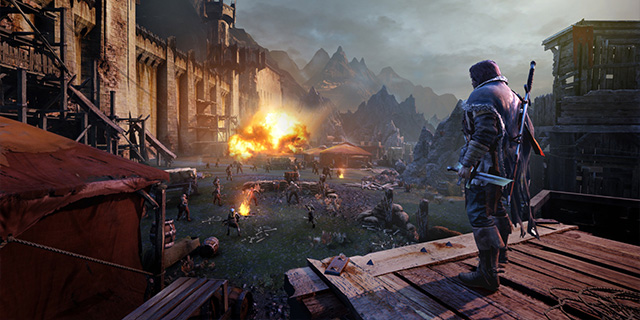
Like with any licensed property, games based on Lord of the Rings, and Middle-earth as a whole, have been mixed. There are certainly a few stand-outs, but there are just as many (if not more so) poorly made cash-grabs. With such a rich lineage from which to borrow, the potential for an excellent game in this universe seemed untapped. Middle-earth: Shadow of Mordor, Monolith’s take on the series, is different, taking a license in exciting directions rarely seen from larger studios.
Shadow of Mordor tells the story of Talion, a ranger who loses his family to the minions of the series’ big bad himself, Sauron. He is quick to discover, despite his apparent death, that he is still alive and his soul tied to the spirit of an elf with a mysterious past. He then sets out for — you guessed it — revenge on those who killed his family. The ties to Lord of the Rings and the mythology of Middle-earth are fascinating, but Talion’s tale is particularly one-note, as is his character, leaving you with a bland story that won’t even win over even the most diehard Tolkien fans.
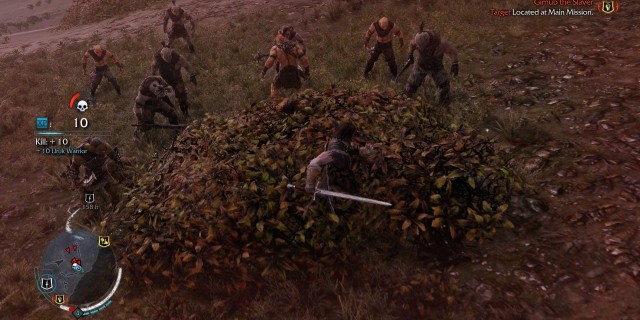
After some introductory cutscenes and prerequisite tutorial missions, you are free to roam the land of Mordor and enjoy Talion’s adventure at your own pace. It won’t be long before you notice just how familiar the game’s core mechanics seem. The running, climbing and stealth all feel remarkably similar to Ubisoft’s Assassin’s Creed series, but these mechanics are significantly tighter than any game in that series, making the actual act of exploration enjoyable. You’ll never stumble over yourself or climb up walls you don’t intend to scale and, when necessary, being able to flee from danger at a moment’s notice is always reliable.
You’ll also quickly notice how the game’s combat feels ripped right out of a Batman Arkham title, but instead you’re armed with a sword and powers that fit in just right with the universe. Again, it’s not particularly distinctive, especially when it’s been done by several games since, but it’s handled well here and makes taking on large groups of Orcs entertaining. Shadow of Mordor doesn’t attempt to hide its influences, yet it handles all of these mechanics as well as the two series it borrows from.
Mordor is full of side missions and collectibles, as one might expect, making it all feel standard in a world full of sandbox titles not unlike it. None of these aspects of the game stand out in any particular way, either. The story missions, while mostly enjoyable, won’t surprise anyone who has played similar games. It initially seems like Shadow of Mordor is just another standard third-person action game, but it does have one thing that sets it apart: the Nemesis system.
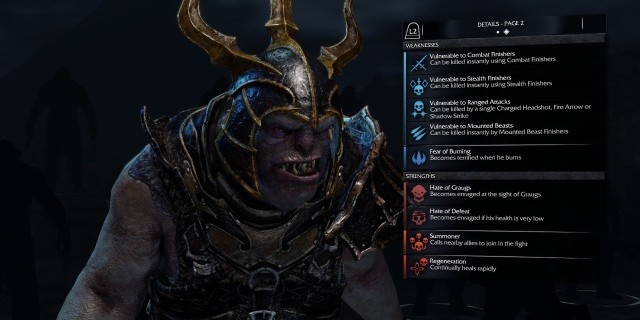
It isn’t long before you run into your first of many Orc captains, each having its own unique name, attributes and personality. These guys are scattered all throughout Mordor, and with each encounter comes a new story to tell, leading the way to the game’s most memorable moments. How you handle these situations will dramatically shape these enemies and how they react to you in the future. You could choose to run, making them mock your cowardice in later encounters, or fight. If you win, you may just see them show up again for revenge, but if you lose, they gain strength and get promoted among Sauron’s ranks, making them an even bigger threat in the future.
Once you spend some time in Mordor, your game will quickly become littered with these encounters. Sometimes you take on a side mission that has you taking on one of these special Orcs, but often you’ll run into them on a completely different quest or simply roaming the landscapes. This is especially true if the Orc is hunting you down for revenge, leading to some crazy encounters with five or more of these enemies each dying to get a piece of Talion.
It wasn’t long before I began seeking out my own revenge, so let me tell you the story of Zogdush Pain-Lover. I initially set out to kill this captain simply because he showed up on my map and I was in the area. I ambushed him, took out his foot soldiers and then was ready to end his life when another Orc captain, one I thought I had killed hours ago, showed up to take his revenge. Zogdush escaped and, as a result, became a warchief, the highest rank in Sauron’s army. This is only where my troubles began.
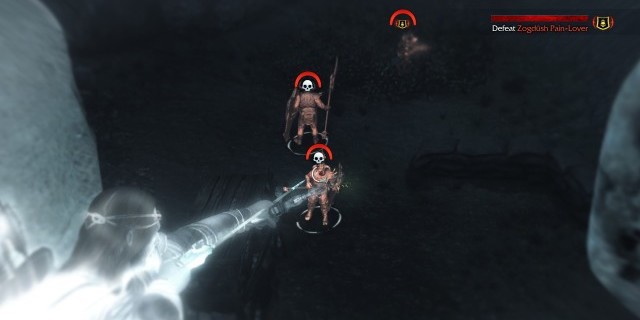
Zogdush soon had his own stronghold, making the next several fights with him surprisingly challenging. He had two Orc captain bodyguards by his side at all times, one of which held a grudge with me for cutting up his face in a previous encounter, and was surrounded by minions ready to pounce on me at a moment’s notice. With each defeat, he grew stronger, making it feel like a near-impossible task to take him out. It was then that I began taking advantage of the weaknesses of my enemies.
One of his bodyguards was terrified of fire, specifically of being burned alive, so I used that to my advantage. I watched as he ran away from Zogdush’s stronghold after I managed to lure him toward a small camp fire that I was able to make erupt into larger flames. The second bodyguard was weak against ranged attacks, allowing me to use my arrows to dispose of him quietly. Zogdush, despite his immense strength, was bested thanks to some careful planning. I encountered him again later, eager for revenge, but he never stood a chance after that.
Despite how capable you may seem, you’ll often find the best strategies are those that require more planning. While my pride initially told me I could take on whoever I wanted and win because, hey, I’ve played action games before, enemies like Zogdush quickly taught me how wrong I was. Running away is always a valid strategy, and the strengths and weaknesses of each Orc captain and warchief allow you to incorporate more strategy in a battle than you might traditionally expect in an action game. You’ll be surprised by just how many different plans of attack you can devise, and also how quickly those plans can go bad really fast thanks to the dynamic Nemesis system.
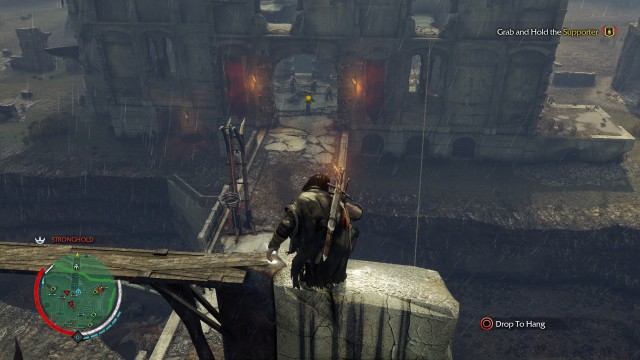
These encounters, no matter how big or small, help make the world of Shadow of Mordor feel alive. You never know when you’ll encounter an Orc with a grudge or one simply looking to kill you for interfering with his hunt. The more you traverse the world, the more stories you’ll have to tell, leaving you with an ever-changing experience that feels wholly unique despite its unmistakable influences. The combat and stealth are finely tuned and the game plays as well as the best action games on the market, but the Nemesis system truly sets it apart.
It doesn’t end there, however. After a significant chunk of the story has been completed, you gain access to the one of the game’s best tricks: branding. This allows the player to essentially take control of Orcs, no matter what rank, and use them to their advantage. It starts out simple, such as tracking down a Warchief’s bodyguards and branding them, giving you the upper hand in a future battle, but it can get incredibly complex with the right amount of planning. It’s a small addition to an already brilliant system, but with the right mindset it can be used in some thrilling ways.
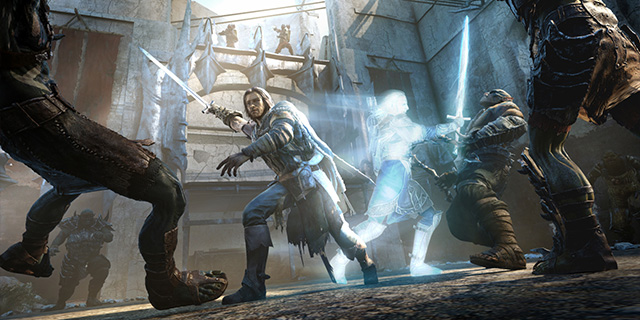
At first glance, Shadow of Mordor is an unsophisticated action game that takes elements from many other notable series, never forging an identity of its own. Thanks to the multi-faceted Nemesis system, however, it’s one of the best licensed games to come around in years. It turns an otherwise-mundane world into one with limitless potential, giving the player access to an endless supply of encounters and stories. It succeeds simply because it forges an identity while still maintain what works so well in games like it.
Pros: Fantastic Nemesis system gives the world life, excellent combat and stealth mechanics
Cons: Unremarkable story



















